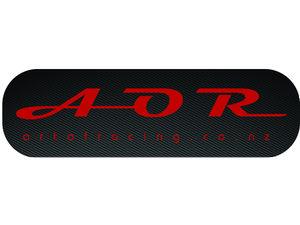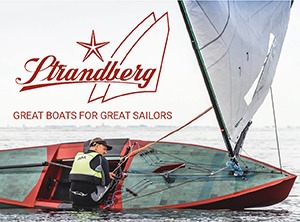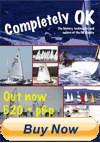You are here: okdia.org > technical > technical manual > first beat
Technical Manual
Sailing The First Beat
by Trevor Gore
It is well known that if you are in the leading bunch at the first mark you stand a good chance of staying there until the last mark.
Although the start is an important part of the race, it is what happens immediately afterwards that is most important, especially on big Olympic courses at WQ level and above. Generally it is good sailors winning races, but even the best sailors cannot make the best starts all of the time.
Having crossed the line, the race for real starts, and a route up the first beat must be chosen. If you have delayed that decision until after the start, it is too late. The route should have been decided well before that.
Where you start on the line, as well as being influenced by line bias, current, expected bunching, etc., should also be influenced by your route up the first beat. If you intend going to starboard it is dangerous to start at the port end of the line (unless there is a huge bias there) because you have to cross the whole fleet to make the starboard side. If your start is indifferent, i.e. the usual case, you may end up ducking behind every boat in the fleet.
So, how does one decide a route? Firstly, consider the present condition of wind, tide, waves and other boats, these being the major influencing factors.
Consider the wind:
What sort of wind is it? What direction? How much is it shifting? How frequently? Are there any static shifts due to topographical features ashore? Is the wind changing in strength? The reasons for these questions . . ..?
The wind will either be due to a prevailing pressure system, or a locally generated thermal breeze (e.g. a sea breeze) or a combination. Usually one form predominates. The type of wind helps define the way it might change through the race.
If the wind is, for example. coming off the land it will not be as steady as if it came off the sea. Playing the shifts inshore may be beneficial.
Having found the mean wind direction and the magnitude of the shifts, a decision can be made as to whether they are worth playing. The shift frequency will define your tacking frequency and when to expect the next shift.
Stationary wind bends, or slow continual changes in one direction can prove extremely useful if they can be detected. If you will be beating into a curved wind, ALWAYS sail up the same side of the course as the centre of curvature, unless there are overwhelming reasons for doing otherwise; i.e. sail the inside of a wind bend.
The wind strength will decide whether or not you wear weight. It may be advantageous to wear weight to windward in strengths upward of force 2, but if the downwind work is only marginal planing the penalties for carrying that weight can be severe. Remember, the weight goes all the way round the course with you.
Consider the tide:
What direction is it relative to the wind? Is it of equal strength over the course? Is it curved? What state of tide is it?
If the direction is favourable, you want to be in it, so find the strongest bit. If you are sailing in a smallish bay (1-2 miles across) the tide will almost certainly be curved. If you happen to be beating against a curved tide, sail the opposite side of the course from the centre of curvature, i.e. sail the outside of a tide bend. Determine what stage in the race (if at all) the tide will change. This will affect your route decisions.
Consider the waves:
What is there direction relative to the wind? Do they vary over the course? Are they big enough to ride? Can you identify changes in depth or current due to them? Which is the fastest tack when beating? Will the waves change with the tide?
Waves on a beat are usually bad news. Try to avoid them. If their direction is different from the wind direction, one tack will provide much easier sailing. If they are only just big enough to ride, that is a good reason not to wear weight. Use the waves as a tidal indicator.
Consider the other boats:
Other boats are seldom good news after the start. Before the start observe the other boats setting up on the first beat, and try to ensure that you do not miss anything that they might find useful. It is always best to avoid crowds, and collisions and protests at all costs. A protest committee will not necessarily exonerate you even if you were in the right. Most protest committee decisions seem to be based on fictional evidence and consequently the outcome is a total lottery.
Having considered the present conditions, take out your crystal ball and consider the future.
Wind:
Having logged the shifts, predicting where it will shift next should not be too difficult, and should help decide your position on the line. Pressure system winds tend to have comparatively short duration small shifts (- 5~). At periods of greater than 2 minutes these are worth playing, other things being equal, up the centre of the course. If the periods are much shorter your tacking has to be pretty neat.
In a sea breeze the wind follows the sun round, so take the starboard side of the course (in the northern hemisphere!) which should be progressively freed, and play the shifts local to you at any particular time. In thundery weather, the wind lives under the clouds, so look for it there. If you anticipated a geographical bend, go for it on the first beat; any dummy can find it by the second beat, but it is too late then. And what about strength? Do not carry more weight than necessary. If the wind is dying you do not need 301b of extra weight on the reaches.
Tide:
Anticipate your approach to the windward mark with respect to the tide's strength and direction there. You do not want to be putting short hitches in with boats piling in on top of you cutting up your wind. Make sure you approach from the correct side. If rounding to port, at least the last 25m should be on starboard tack always, but in an adverse current make the major approach to the mark from the side on which tack the tide is closest to head on. Phase this with the wind shifts as best you can. 10m can mean as many boats at the windward mark, and as the fleet stretches down the reaches, this can easily become 100m. Plan the beat such that the time spent in the most advantageous or least adverse current is maximised. If you have to cross a channel of stronger adverse tide, and the channel meanders, cross at a point where you take the current on the lee bow. If high or low tide is expected during the race, anticipate a change of current direction and position yourself on the side of the course to take best advantage of it. Remember to keep to the outside of larger scale tide bends.
Waves:
Wave technique warrants an article of its own. However, avoid the big ones up the first beat, tack on the crests, and keep the boat moving. Try to maintain a rhythm over the waves avoiding the disturbances of other boats' wakes.
Changes in wave pattern tend to be provoked by changes in wind or tide which usually take precedent.
Other boats:
Do not mix with other boats, sail your own race. Anticipate the movements of the other boats, such that when you have to cross tacks you do not get put about onto an unfavourable shift. If you are on a winner it pays to let port tack boats cross ahead. Bear in mind your tactics when you next cross tacks.
By making a judgement on each of the individual factors, the decision concerning them all, and the subsequent choice of route becomes much easier. Collect the data, feed it into your on board computer and make the conditions work for you. After all, you are an intelligent athlete, aren't you?
Note
Trevor Gore at his most practical. The article is written with large triangular courses in mind, in tidal waters, with a beat of a mile or more.










